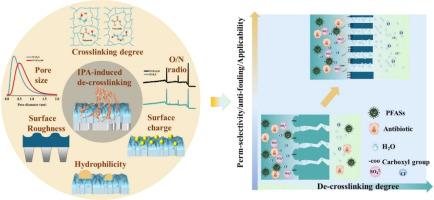Unveiling Decrosslinking Degree on Polyamide Nanofiltration Membranes: Structure–Performance Relationship and Micropollutant Removal
IF 12.4
1区 环境科学与生态学
Q1 ENGINEERING, ENVIRONMENTAL
引用次数: 0
Abstract
Polyamide (PA) nanofiltration membranes (NFMs) possess highly crosslinked structures, leading to several technical limitations such as poor selectivity, low permeance, and severe fouling. This study devised a novel isopropanol (IPA)-induced decrosslinking strategy to systematically modulate PA crosslinking density by precisely controlling IPA concentration and temperature. IPA induces swelling effects and hydrogen bonding, selectively extracting loosely crosslinked PA chain segments and allowing for network relaxation and rearrangement to form a uniform structure with lower overall crosslinking density. The optimised NF membrane post-treated with IPA at 60°C (NF-IPA@60) achieved 32.94% decrosslinking with enhanced surface negative charge density and enlarged pore size. Compared to the control membrane (NF-H2O), NF-IPA@60 exhibited higher pure water permeance (27.3 LMH/bar) while maintaining 92.7% Na2SO4 rejection. Enhanced Donnan exclusion significantly improved micropollutant removal, particularly for anionic contaminants such as perfluorooctanoic acid and perfluorooctanesulfonic acid. Pearson correlation analysis established clear structure–performance relationships for the decrosslinking strategy. Natural water testing showed that NF-IPA@60 exhibit total organic carbon removal efficiencies exceeding 88.2%, with 3.15-fold improvement in organic/mineral selectivity and excellent antifouling properties. This study provides a novel theoretical framework and technical approach for high-performance NFM design, offering significant potential for overcoming traditional membrane technology bottlenecks.

揭示聚酰胺纳滤膜的脱交联度:结构-性能关系及微污染物去除
聚酰胺(PA)纳滤膜(nfm)具有高度交联结构,导致一些技术限制,如选择性差,低渗透和严重的污染。本研究设计了一种新的异丙醇(IPA)诱导的交联策略,通过精确控制IPA的浓度和温度来系统地调节异丙醇的交联密度。IPA诱导溶胀效应和氢键,选择性地提取松散交联的PA链段,使网络松弛和重排形成均匀的结构,整体交联密度较低。优化后的纳滤膜经60°C IPA处理后(NF-IPA@60),脱交联率达到32.94%,表面负电荷密度增强,孔径增大。与对照膜(NF-H2O)相比,NF-IPA@60具有更高的纯水渗透率(27.3 LMH/bar),同时保持92.7%的Na2SO4截留率。增强的Donnan排除显著改善了微污染物的去除,特别是对阴离子污染物,如全氟辛酸和全氟辛烷磺酸。Pearson相关分析为去交联策略建立了清晰的结构-绩效关系。天然水测试表明,NF-IPA@60的总有机碳去除率超过88.2%,有机/矿物选择性提高3.15倍,具有优异的防污性能。本研究为高性能NFM设计提供了新的理论框架和技术方法,为克服传统膜技术瓶颈提供了巨大的潜力。
本文章由计算机程序翻译,如有差异,请以英文原文为准。
求助全文
约1分钟内获得全文
求助全文
来源期刊

Water Research
环境科学-工程:环境
CiteScore
20.80
自引率
9.40%
发文量
1307
审稿时长
38 days
期刊介绍:
Water Research, along with its open access companion journal Water Research X, serves as a platform for publishing original research papers covering various aspects of the science and technology related to the anthropogenic water cycle, water quality, and its management worldwide. The audience targeted by the journal comprises biologists, chemical engineers, chemists, civil engineers, environmental engineers, limnologists, and microbiologists. The scope of the journal include:
•Treatment processes for water and wastewaters (municipal, agricultural, industrial, and on-site treatment), including resource recovery and residuals management;
•Urban hydrology including sewer systems, stormwater management, and green infrastructure;
•Drinking water treatment and distribution;
•Potable and non-potable water reuse;
•Sanitation, public health, and risk assessment;
•Anaerobic digestion, solid and hazardous waste management, including source characterization and the effects and control of leachates and gaseous emissions;
•Contaminants (chemical, microbial, anthropogenic particles such as nanoparticles or microplastics) and related water quality sensing, monitoring, fate, and assessment;
•Anthropogenic impacts on inland, tidal, coastal and urban waters, focusing on surface and ground waters, and point and non-point sources of pollution;
•Environmental restoration, linked to surface water, groundwater and groundwater remediation;
•Analysis of the interfaces between sediments and water, and between water and atmosphere, focusing specifically on anthropogenic impacts;
•Mathematical modelling, systems analysis, machine learning, and beneficial use of big data related to the anthropogenic water cycle;
•Socio-economic, policy, and regulations studies.
 求助内容:
求助内容: 应助结果提醒方式:
应助结果提醒方式:


